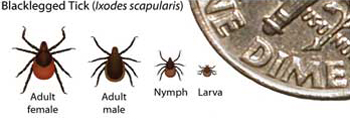FRAMINGHAM, MA – With warmer weather finally arriving, local doctors and emergency room staff are seeing an increase in deer tick bites, and anxious parents worried about the bacteria they carry which cause Lyme Disease.
Doctors at Framingham Pediatrics report treating children with deer tick bites every week last season, and this year should be no different.
Deer Ticks are common throughout all of Massachusetts and can be active from April through October and are most active in June, July and August. Adults deer ticks can be active any time of the year when temperatures rise above freezing.
The deer tick, or “blacklegged tick”, (Ixodes scapularis), bites and feeds on blood at all stages of its 2-year life cycle. Adult females have a reddish hind section, while males are smaller and brownish in color. The chart below shows the insect’s appearance, and relative size at each stage of development.
Unlike mosquitoes which bite human or animals, feed on blood for a few moments, then move on — deer ticks will attach to a host for 3 to 4 days and engorge themselves with blood before dropping off. Being bitten does not immediately cause illness — the tick needs to be attached to a host for 24 hours to transmit the bacteria, (which can cause Lyme Disease).
According to the Center for Disease Control, (CDC), “The first sign of infection is usually a circular rash called erythema migrans or EM. This rash occurs in approximately 70-80% of infected persons and begins at the site of a tick bite after a delay of 3-30 days.”
The rash spreads out circularly from the bite, then redness in the center fades resulting in a distinctive donut shaped rash.
Symptoms of Lyme Disease can include; muscle and joint pains, arthritis, sleep and fatigue issues. Symptoms can last months or years. Most cases of Lyme Disease can be treated with antibiotics if administered shortly after the tick bite occurs.
To avoid being bitten by a deer tick in the first place, it’s suggested that whenever gardening, camping, hiking or enjoying other outdoor activities in humid grassy or wooded areas, that you:
- apply insect repellent which contains 20% or more DEET to skin or clothing.
- apply inset repellent which contains Permethrin to clothing and outdoor gear.
- wear a long sleeve shirt and pants with the shirt tucked in, and pants tucked into socks, (light colored clothing with no patterns will make it easier to spot any ticks that may cling to your clothes).
- when hiking, walk in the center of trails away from grassy areas and leaf litter.
- after being outdoors, (even in your own yard), check your entire body paying special attention to head, scalp, underarms, back of knees, naval, waist and all areas with body hair.
- be sure to check pets, clothing and any gear for ticks too.
If you have been bitten by a tick, remove it by pulling it from the skin with tweezers. While not all bites cause Lyme disease, it’s best to make you doctor aware that you have been bitten, and follow professional medical advice.
For additional information on Deer Ticks, Lyme Disease, and suggestions for creating tick-free areas in your own yard, visit U.S. Center for Disease Control, (CDC) website at: www.cdc.gov
###

